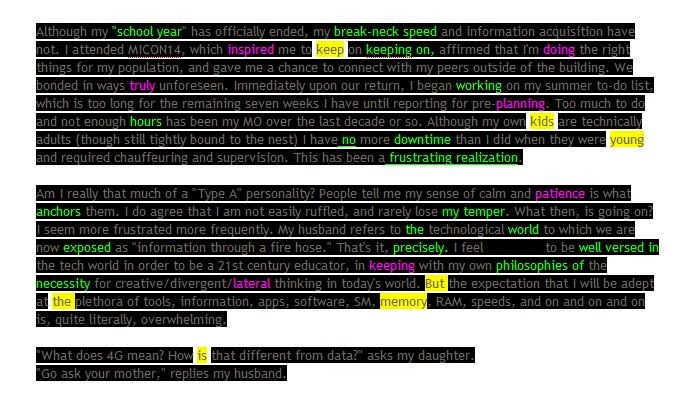Most state test writing demands two things- the
ability to use the techniques of the genre and to think on your feet. The one
thing lacking in many ELA classrooms, often including my own, is giving
students time to think, plan and create.
These opportunities do not have to be overly time consuming, but can
increase student motivation, creativity and strengthen their thinking skills.
The Common Core Standards support each idea below and depending on the depth of
the assignment, takes very little planning to accomplish. Ultimately providing
more challenging writing ideas help our students to think on their feet AND
instills motivation and inspiration about the limitless possibilities of
writing.
Visual Poetry
W.8.6. Use
technology, including the Internet, to produce and publish writing and present
the relationships between information and ideas efficiently as well as to
interact and collaborate with others.
The first tool: Visual Poetry. Now this is a relatively
simple tool, but it could take student poetry to a different level. I can see
students getting excited not just about seeing their poem in a different format,
but in planning what shape or structure their poem will take when using this
tool. Shorter poems would work best-
students might even take the most important words from their writing to create
a visual. This tool would also be
something unique that students could use in writing workshop when they claim to
be “finished”. Take the activity a step
further and have students reflect on why they chose that shape/format for their
poem. How does it compliment what you
wrote? And there is nothing wrong with
creating visual poetry by hand too!
 | ||||||||
| I created this from a poem I wrote some time back. The good thing- Students are WAY more creative than we sometimes are..... |
You can find other ways to create/hack poetry Here
Hack Some Writing – Google Docs
W.8.6. Use
technology, including the Internet, to produce and publish writing and present
the relationships between information and ideas efficiently as well as to
interact and collaborate with others.
L.8.5. Demonstrate
understanding of figurative language, word relationships, and nuances in word
meanings.
Another idea is to create Found Poetry from a piece
of writing. In the #CLMOOC, Michelle
Stein uploaded a document from something she wrote in reflection. She
highlighted (or changed the color of the font) of particular words throughout
the piece to create a ‘Found Poem’ and challenged the rest of us to do the same
on her Google Doc that she shared. I
went in and created my poem changing certain words to green. And so on. The
possibilities are endless in how students might use this technique.
Individuals, small groups- assign a color and go! You could limit students to a
particular paragraph, etc. You could
upload a piece of your own writing, a piece of student writing, even writing
from an author or poet and allow students to hack the writing to create
something new. Students or the teacher
can compile the created poems on a Google Doc, in Haiku Deck, etc. and then hold a discussion on what processes
were taken to decide on the words they chose for their poem. What stood out to
you first? What frustrations did you experience? When did you know your poem was ‘finished’? What mood or tone is displayed based on the words chosen? What words have a strong connotation? What is the connotation? What do you think their poem means? Why? Provide evidence.
 | |
| In this excerpt- three people took part- one in yellow, one used green and the other person used purple. |
Twitter Essay
W.8.4. Produce clear
and coherent writing in which the development, organization, and style are
appropriate to task, purpose, and audience.
W.8.6. Use
technology, including the Internet, to produce and publish writing and present
the relationships between information and ideas efficiently as well as to
interact and collaborate with others.
If you are lucky enough to be able to use Twitter in
the classroom, you might try a Twitter Essay. (Of course with older students you might
assign this as a flipped assignment) First introduced on the #CLMOOC and in
this blog post- the idea is to provide a prompt for students
to respond to in just 140 characters (Including the
hashtag). Once students post, they are
also required to find one or two student posts and respond in a peer review post.
The teacher would have to be specific with the prompt as well as how students
are to respond to each other’s ideas. I went to Twitter to find #twitteressay and saw prompts such as:
What is the root of discrimination?
How has poetry affected your life?
Kevin Hodgson posted multiple Twitter Essays on hisblog-
Other ideas that would work like a Twitter Essay
would be the six word memoir or tweet your life story in 140 characters or
less, even flash fiction. And if Twitter
simply isn’t an option, try Edmodo or add your posts to a shared Google Doc-
having students reply via comment option.
And to end- a really neat idea I’d like to try with
students someday- Paper Circuitry
This site has a user guide, videos and how it
connects to both language arts CCS as well as the Next Generation Science
Standards. A great idea for Stem, an after-school program, that last week of school, etc.
I can see students creating poetry – visual poetry-
poetry in greeting card format- and adding lights to enhance it. Talk about motivation!
You can see
additional ideas on writing at -CLMOOC Make Bank
No comments:
Post a Comment